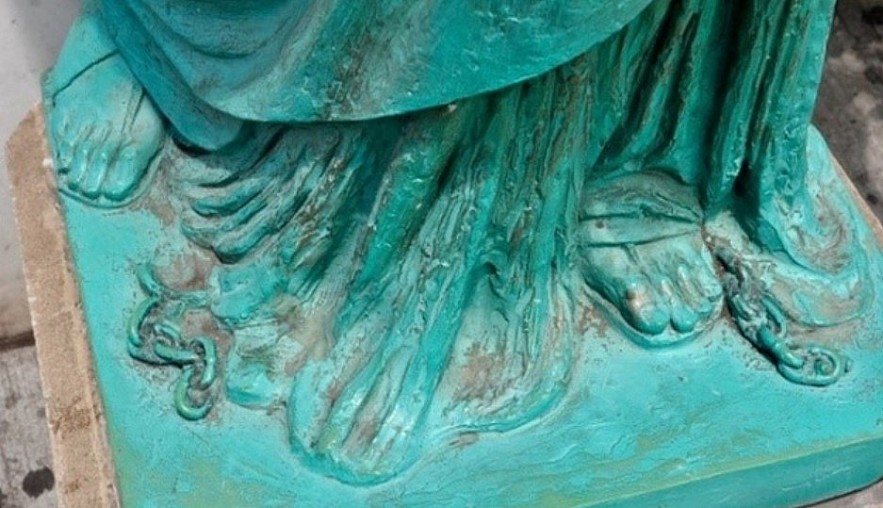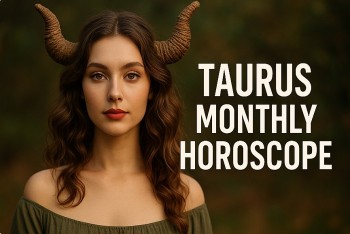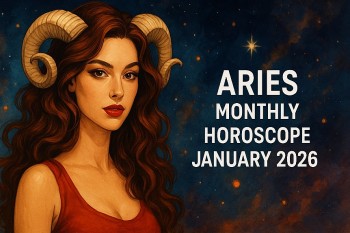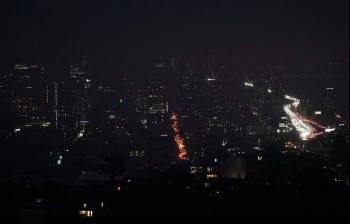Top 15 Mysteries Behind the Famous Artworks of All Time
| Contents |
We can uncover the truth behind the mysteries that seem to have no answers thanks to modern science and technology. Accompany Knowinsiders in unraveling the enigma surrounding the most renowned artworks in global history.
1.Angel and the devil in the painting of 'Old Fisherman'
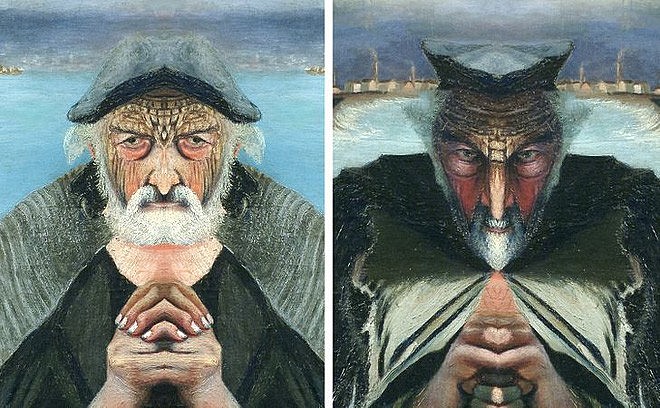 |
| 'Old Fisherman' Painting |
Tivadar Kosztka, a Hungarian painter, was well known to the public with his work "Old Fisherman" in 1902.
Behind the calm sea is a painting of an elderly man with an austere face squeezing a stick with two hands. However, if you place a mirror in the middle of the image, you will notice that it contains two faces with completely opposite expressions.
As a result, if you place a mirror to reflect the face on the left, the old man's face softens, his hands clasped, behind the completely calm sea. On the contrary, if you use the mirror to reflect the old man's face on the right, he instantly becomes extremely frightening with the devil's face and the waves rolling behind him.
2.Mona Lisa used to have eyebrows
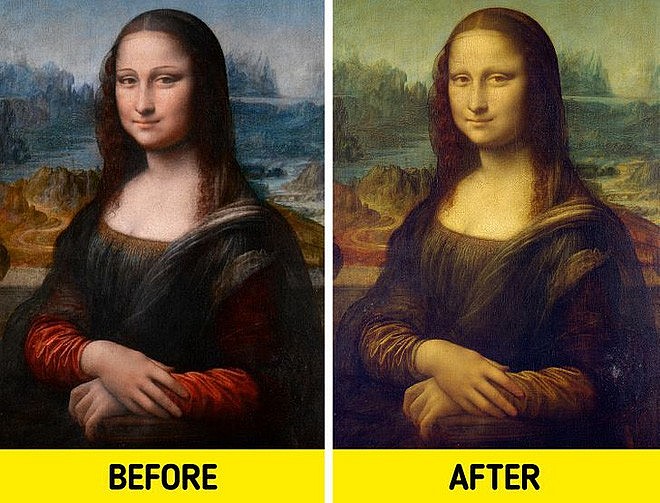 |
| Mona Lisa used to have eyebrows |
We all know that the main character in Leonardo Da Vinci's masterpiece, Mona Lisa, lacks brows and eyelashes. Aside from Mona Lisa's smile, this is the most recognizable aspect of the painting.
However, researchers recently discovered that the original Mona Lisa had both brows and eyelashes. As a result, the scanned image with a resolution of 240 million pixels shows brows and eyelids on both sides of the subject's eyes in the original painting. These details, however, were inadvertently lost during the restoration process of later conservationists.
According to American expert Joseph E. Borkowski, the woman in the photograph must have broken some teeth. Through the enlarged images, Borkowski noticed numerous wrinkles around the Mona Lisa's mouth.
3.The statue of David has abnormal eyes
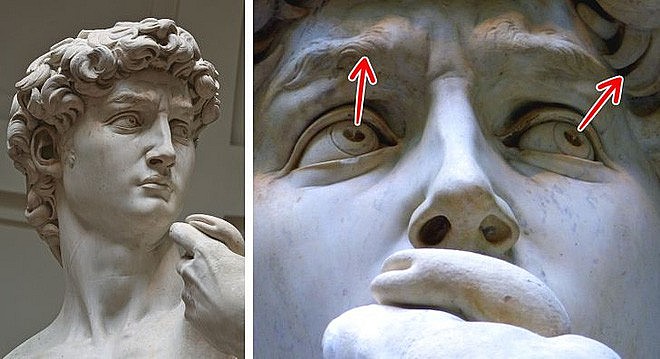 |
| Michelangelo's statue of David |
Michelangelo's statue of David is a masterpiece of human anatomy, but with one unusual feature. Accordingly, David's right eye looks straight ahead while his left eye looks to the left. Michelangelo probably calculated every angle and carved the eyes based on the viewer's position, so the statue would look perfect from different angles.
4.Colored Ancient Greek Sculptures
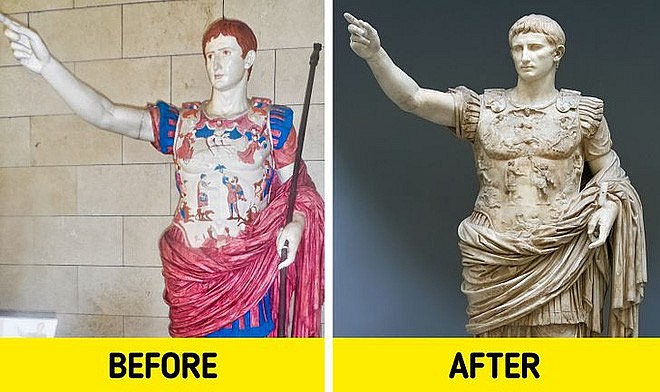 |
| Colored Ancient Greek Sculptures |
When we think of ancient Greek and Roman sculptures, we often think of the characteristically beautiful white marble statues.
In reality, however, this is not the original appearance of these works. Researchers discovered traces of the sculptures' original paint color, revealing the truth about their original appearance. According to research, today's monochrome statues were originally painted in vibrant colors. However, weathering has "discolored" the original paint color over the centuries.
Some traces of the original paint, however, remained, allowing researchers to determine which colors were used and where.
5.Madame X's belt is drawn in a different way
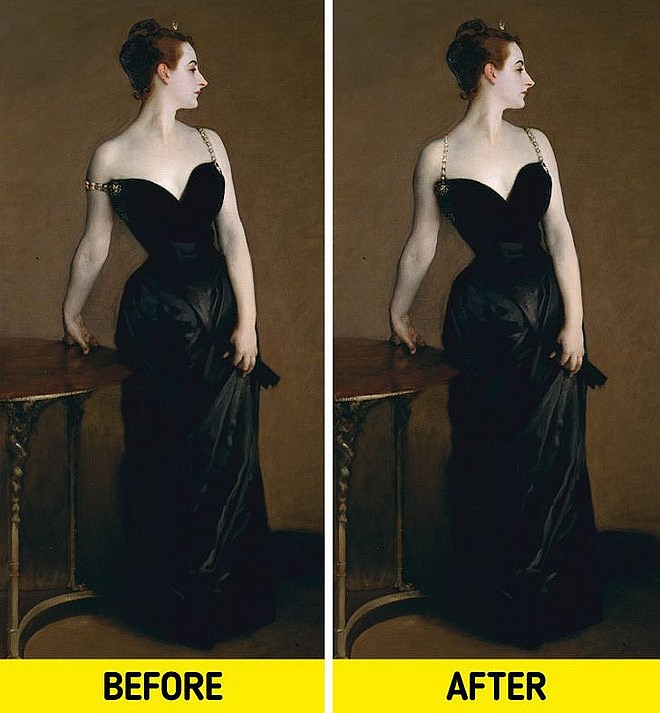 |
| Portrait of Madame X |
Lady X, also known as Portrait of Madame X, is an oil painting by John Singer Sargent that depicts Virginie Amélie Avegno Gautreau, the wife of a banker. Pierre Gautreau is a Frenchman. Lady X emphasizes the contrast between the model's white skin and the dark background by wearing a black dress.
However, the painting received mixed reactions when it was first shown to the public in France in 1884. John Singer Sargent depicted Madame Pierre Gautreau's dress strap slipping off the top. right shoulder in the original version of the painting. This detail, however, was criticized by some as being too revealing.
Pierre Gautreau later asked Sargent to destroy the painting, but he refused because he did not receive a commission. Sargent eventually repainted the strap and renamed the painting Madame X to save his career.
6.The hidden message inside Vincent van Gogh's 'Café Terrace at Night'
Some believe that Vincent Van Gogh was hiding a message through his painting "Café Terrace at Night". Specifically, there are 12 people in the cafe representing the 12 apostles while the waiter in the middle is shaped like Jesus.
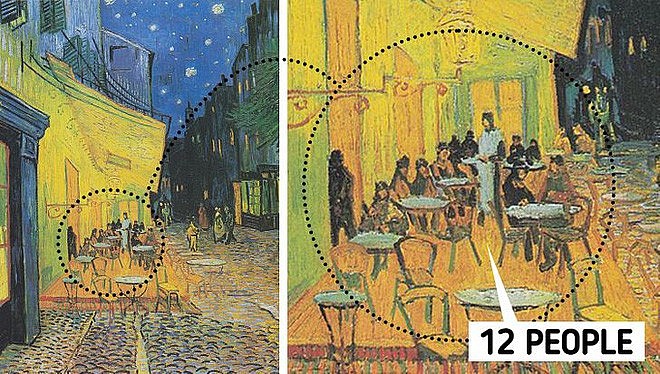 |
| Café Terrace at Night |
There is also a cross symbol right behind the waiter on the window pane. This scene is reminiscent of Leonardo Da Vinci's painting The Last Supper, which depicts Jesus eating with his disciples before being captured by the Roman authorities and crucified.
7.'Lady with an Ermine' originally did not feature a ferret
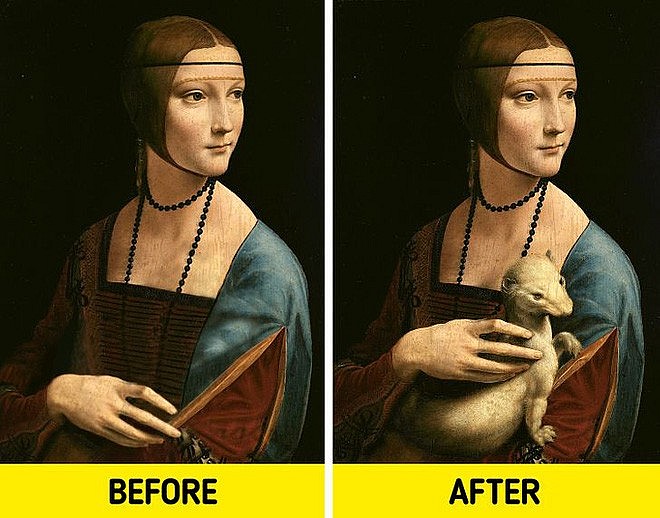 |
| Lady with an Ermine |
Lady with an Ermine is a Leonardo da Vinci painting from around 1489-1490. This stunning oil on walnut board painting measures 40.3 cm wide by 54.8 cm high. Unfortunately, the original background was probably overlaid in the 17th century. The portrait's subject is Cecilia Gallerani, and it was most likely painted when she was the mistress of Lodovico Sforza, Duke of Milan, and Leonardo was working for him.
Later high-tech analysis revealed that Leonardo da Vinci changed his mind several times during the painting process.
Accordingly, after analyzing each layer of Leonardo da Vinci's painting Lady with an Ermine with light reflection technology, researchers discovered that Leonardo da Vinci first painted a version "without the ferret" before editing and re-adding. Da Vinci also edited the fur of the ferret twice in this painting.
Who is this lady?Cecilia Gallerani (circa 1473-1536) is the woman in the painting. A portrait was painted of her when she was 16 years old. She was born in Siena, Italy, and received a good education there. She was fluent in Latin, had musical talent, and wrote poetry. She left her home in May 1489 and went to the Monastero Nuovo, where she met the prince of Milan, Lodovico Sforza. It didn't take long for them to fall in love. |
8. Strange objects in the painting of The Ambassadors
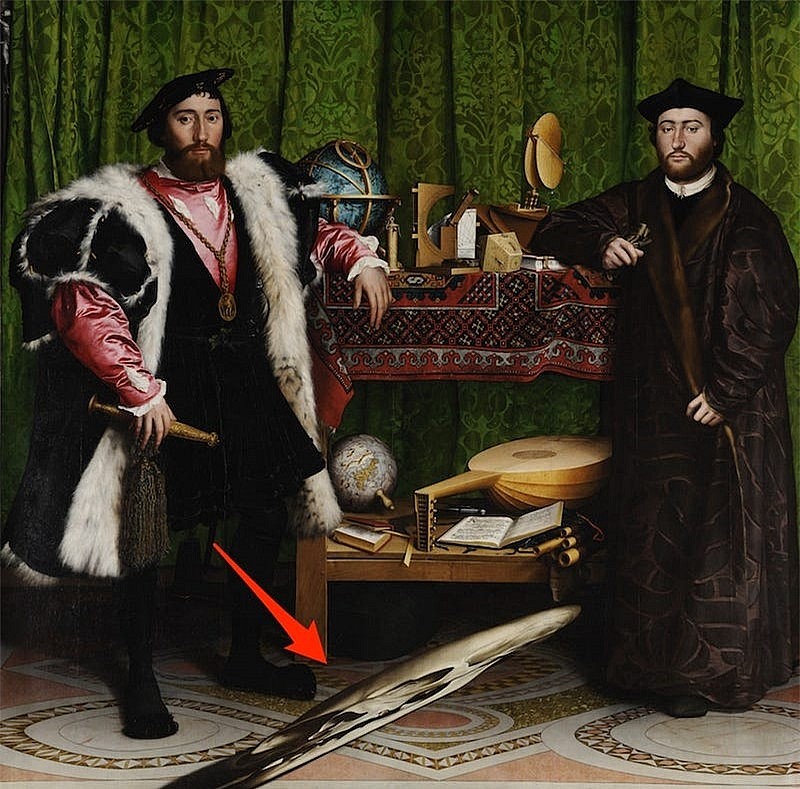 |
| The Ambassadors |
Hans Holbein, a German painter, is well-known for his work The Ambassadors.
Until you notice the "strange object" that is positioned between the two men in the photo, the entire image appears quite normal.
From the right angle, this weird object looks like a distorted skull. Some have proposed that the Latin phrase "memento mori," which translates to "remember that you will die," is symbolized by the skull.
"Memento mori" is purportedly the motto of the man pictured on the left, Jean de Dinteville, the French ambassador.
9. UFO in 'Madonna with Saint Giovannino'
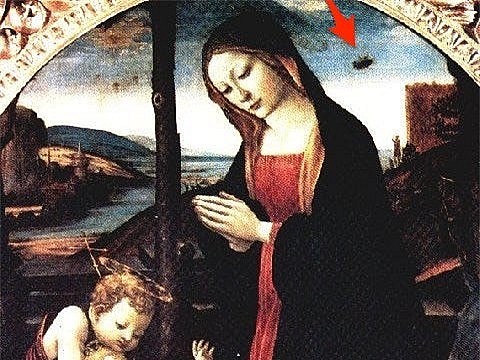 |
| Madonna with Saint Giovannino |
For many years, the circular blurred object in Domenico Ghirlandaio's well-known painting "Madonna with Saint Giovannino" has been the subject of debate.
Some people even go so far as to say it's an alien spacecraft image.
Even though it doesn't appear to be much from this angle, up close the object resembles a UFO.
10. Song in the painting of "The Last Supper"
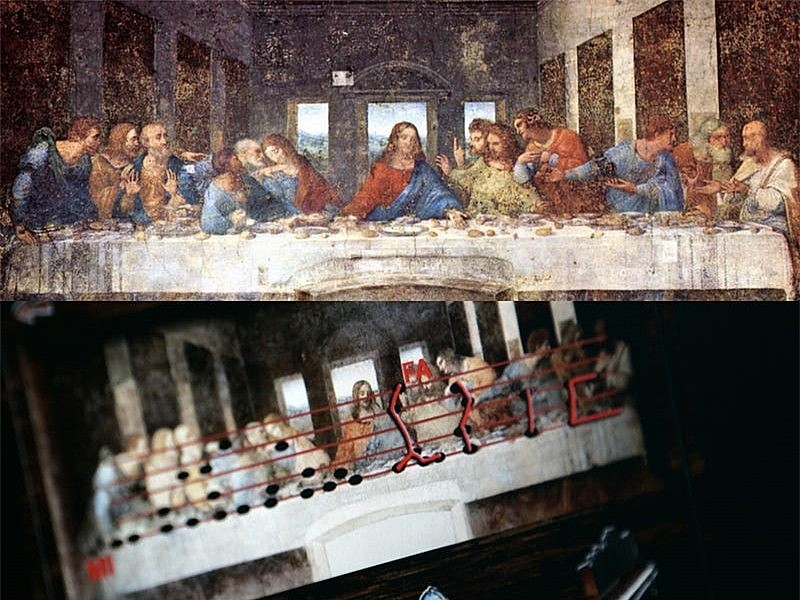 |
| The Last Supper |
The song hidden in the painting "The Last Supper" is the clearest demonstration of Da Vinci's hidden "code" creative style.
An Italian musician has discovered that the arrangement of objects on the table and the posture of the hands of Jesus and the apostles are all symbolic signs for musical notes.
11.The character in 'The Lute Player' is ... a man
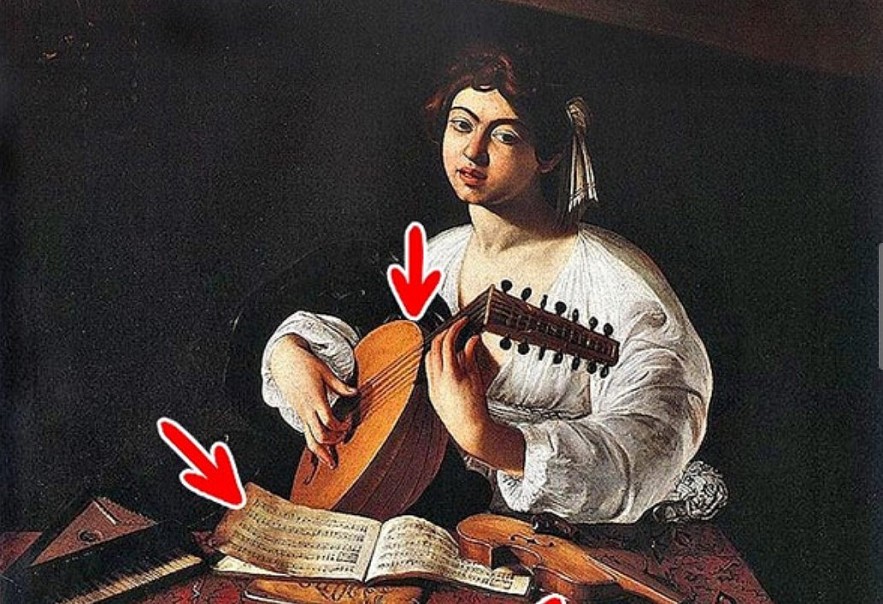 |
| The Lute Player |
For a long time, the character in Caravaggio's painting The Lute Player was considered a woman.
It was not until art critics relied on the musical instruments in the painting that they confirmed that the figure in the painting was a man composing music.
12.The Sphinx has a tail
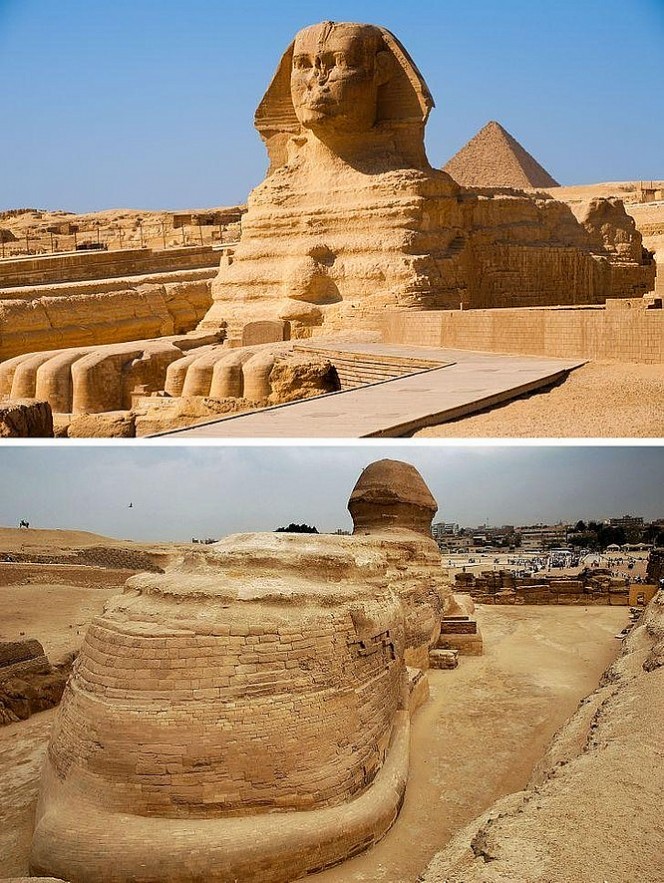 |
| The Sphinx has a tail |
The human head and lion body on the front of this piece of art are well-known features. The Sphinx, however, is a mythical beast that has its origins in the Old Kingdom of Egypt. This character was connected to the sun god Sekhmet in Egyptian mythology. The Sphinx is typically shaped like the body of a lion fused with the head of a sheep, falcon, hawk, or human. The lion's body is adorned with the heads of other animals in accordance with the regional divine ministry.
The Great Sphinx, a monolithic limestone statue situated on Egypt's Giza plateau on the left bank of the Nile, is the most well-known sculpture. The statue's tail extends over 73 meters (240 feet) in length.
13. The mysterious number 7 on the Statue of Liberty
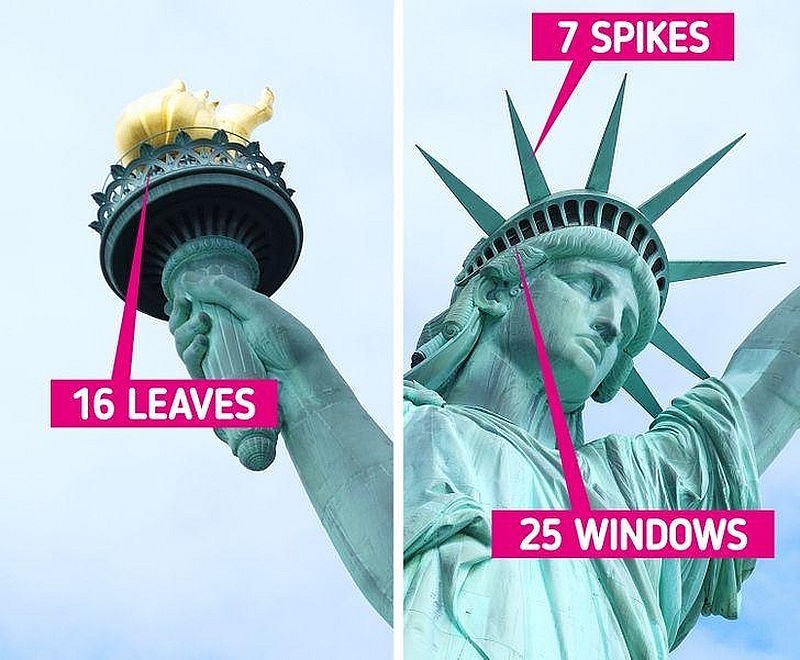 |
| Number 7 on the Statue of Liberty |
According to studies, the fish detailed on the Statue of Liberty are all associated with the number 7. There are 7 thorns on the crown, representing 7 seas and 7 continents in the world. Besides, the number 7 is hidden in other details.
Specifically, on the torch there are 16 leaf motifs, if you add the number 1 and 6, you will get the number 7. In addition, there are 25 spaces on the crown, the sum of 2 component digits is also 7.
The broken chain at the foot of the Statue of Liberty
Many visitors often think that the symbol of America, the Statue of Liberty has two most notable parts, the torch and the book she carries. In fact, the symbol of freedom on the statue is also reflected in the broken chain at the bottom of her feet. This chain symbolizes freedom and the fight against slavery in America. |
14.The apartment on top of the Eiffel Tower
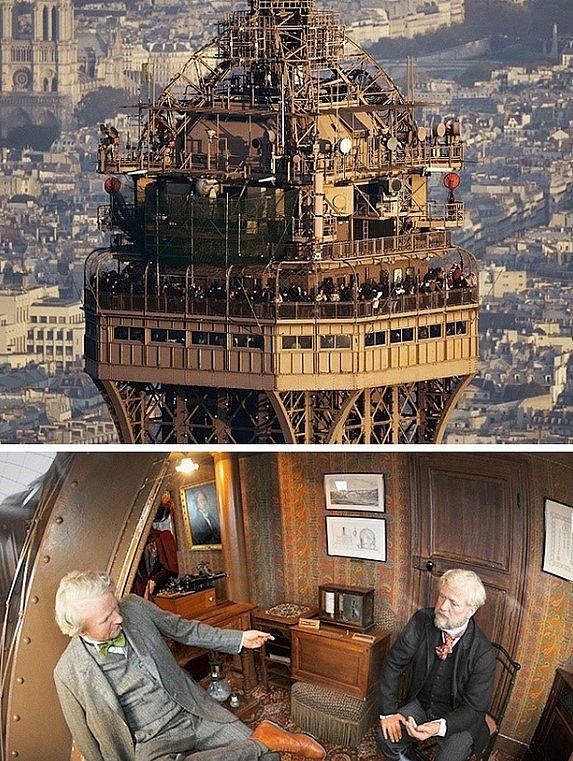 |
| Apartment is located on top of the Eiffel Tower |
At the top of this tower, the man who created the French symbol, Gustave Eiffel, also constructed his own apartment. He hosted his friends in this apartment a lot. And it was in this apartment that he received the great inventor Thomas Edison during winter break.
It is well known that this apartment has two bedrooms, a kitchen, a bathroom, and a living room with a stunning view, among other full amenities. The apartment is now open to the public as a museum.
15. A hidden human brain on 'The Creation of Adam'
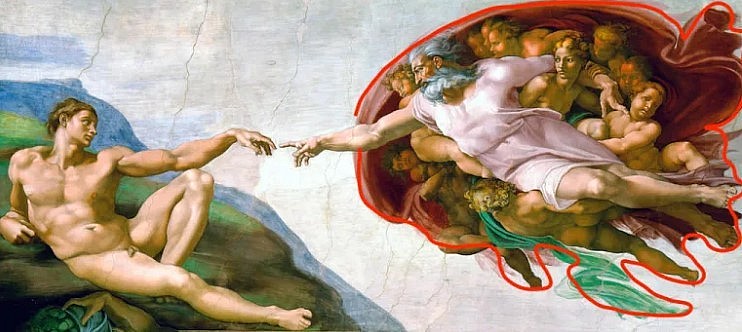 |
| The Creation of Adam |
Of the nine biblical panels that Michelangelo painted on the Sistine Chapel ceiling, "The Creation of Adam" is arguably the most well-known. However, were you aware that a human brain was concealed in the scene?
As it happens, Michelangelo knew a lot about human anatomy. He worked at a somewhat gory job in the church graveyard, dissecting corpses, at the age of 17. Neuroanatomy experts Ian Suk and Rafael Tamargo claim that the painter secretly painted some carefully drawn depictions of specific body parts on the Sistine Chapel ceiling. Furthermore, if you examine the shroud that envelops God in "The Creation of Adam," you will notice that it produces a diagrammatic representation of the human brain.
According to Suk and Tamargo, Michelangelo meant for the brain to stand for the notion that God was giving Adam both life and human knowledge.
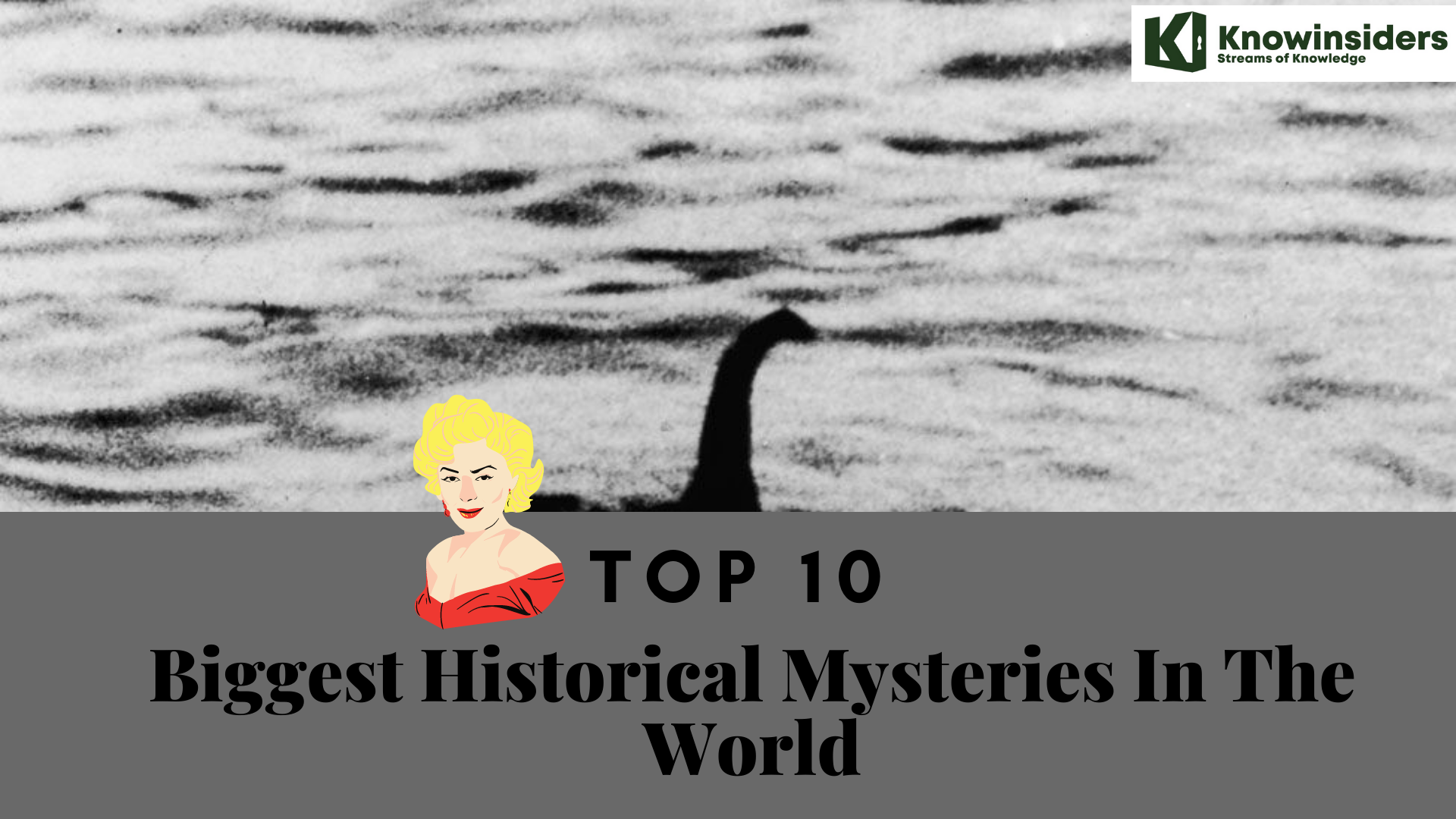 10 Biggest Historical Mysteries In The World That Can Not Be Solved 10 Biggest Historical Mysteries In The World That Can Not Be Solved Not all mysteries will have an answer for it, and some will remain secrets forever. Here is the 10 biggest historical mysteries in the world ... |
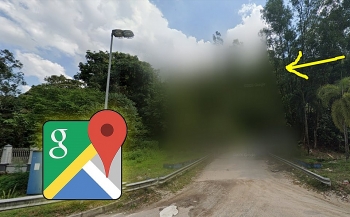 Top 60 Mysterious Places and Things That Blurred by Google Maps, Earth Top 60 Mysterious Places and Things That Blurred by Google Maps, Earth Check out the full list of more than 60 secret places and secret things that were blurred by Google Maps and Google Earth. |
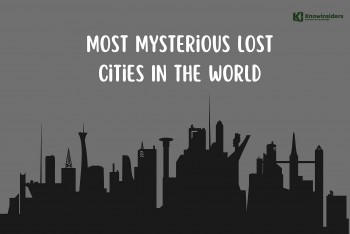 Top 13 Most Mysterious Lost Cities In The World Top 13 Most Mysterious Lost Cities In The World Can you imagine how a city got lost? There are many reasons why a city has to be abandoned. They might be war, natural disasters, ... |
 Top 13 Most Creepy And Mysterious Mysteries That Have Finally Been Explained Top 13 Most Creepy And Mysterious Mysteries That Have Finally Been Explained There have been lots of creepy mysteries about specific people and places on Earth. Some happened accidentally, making haunted stories. Others happened for reasons. |

